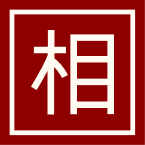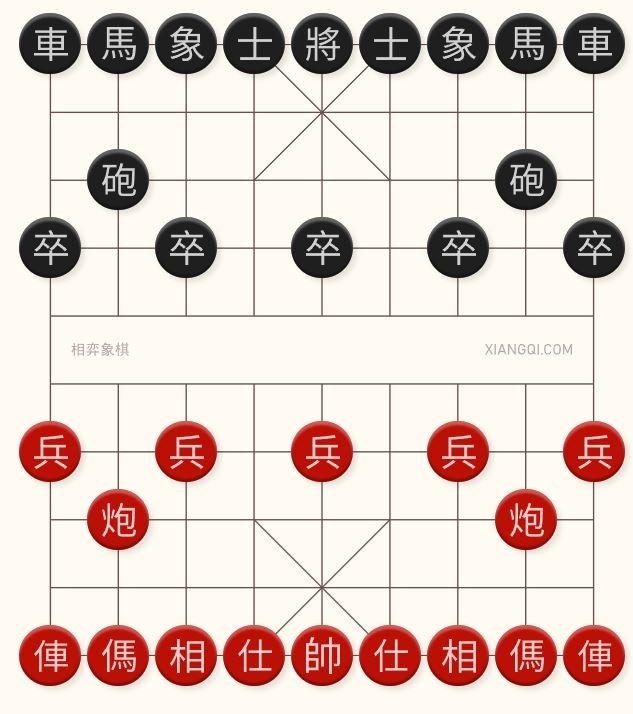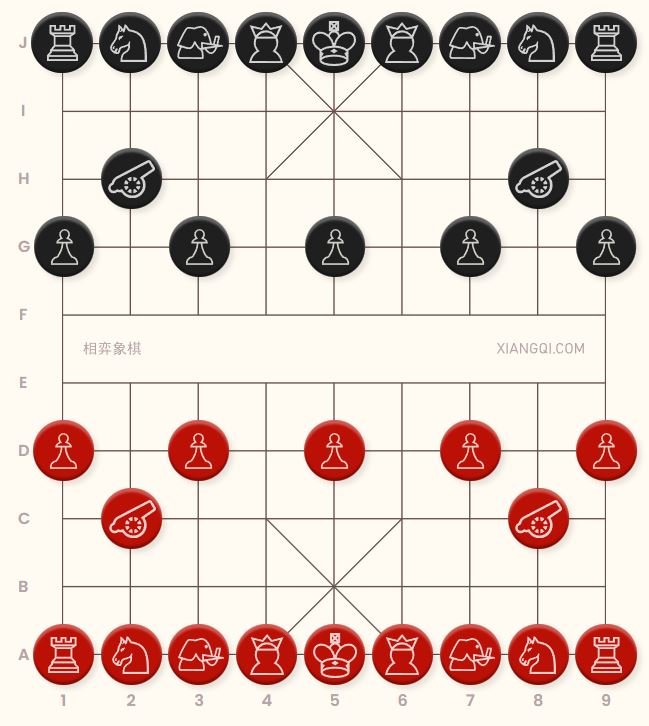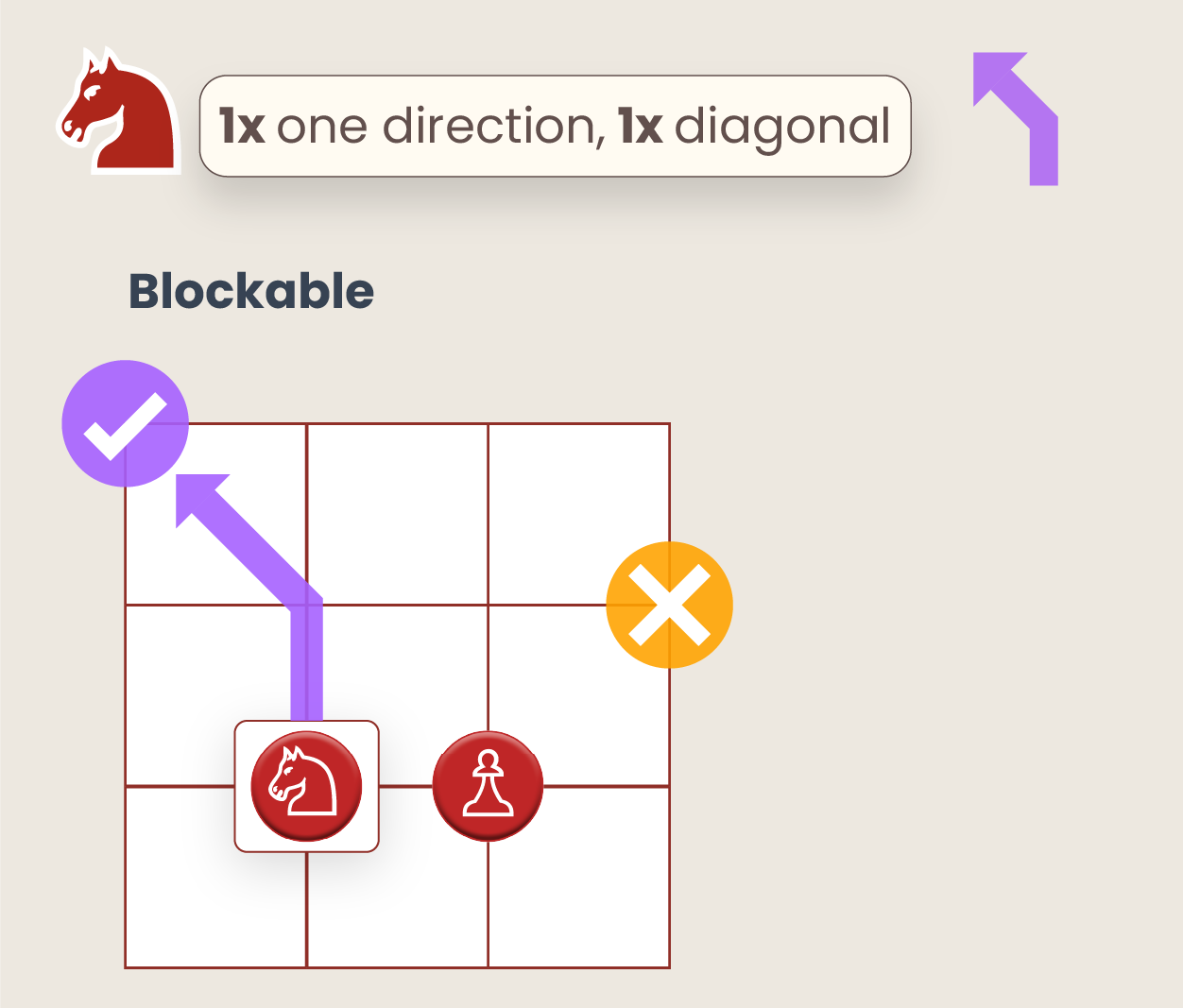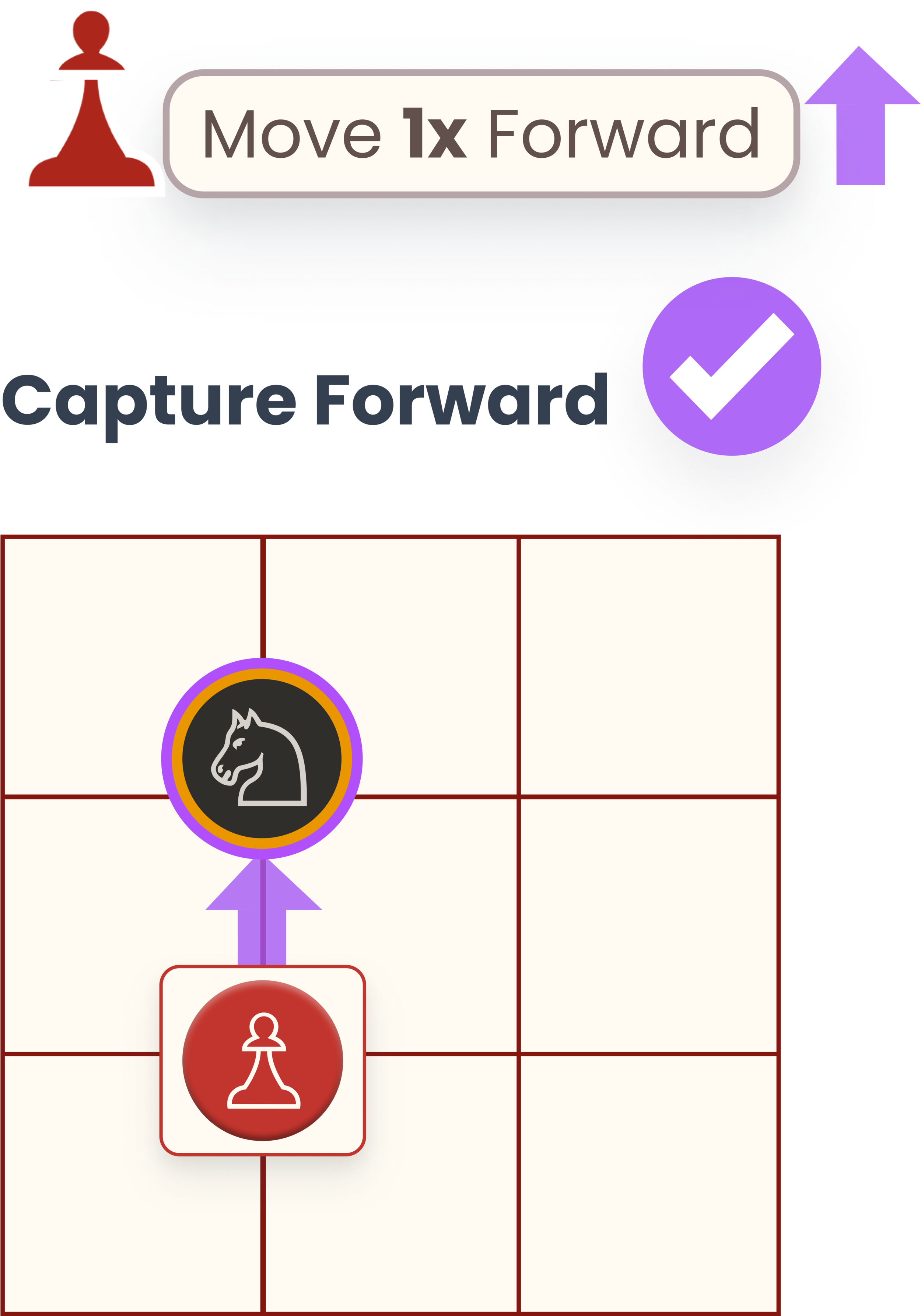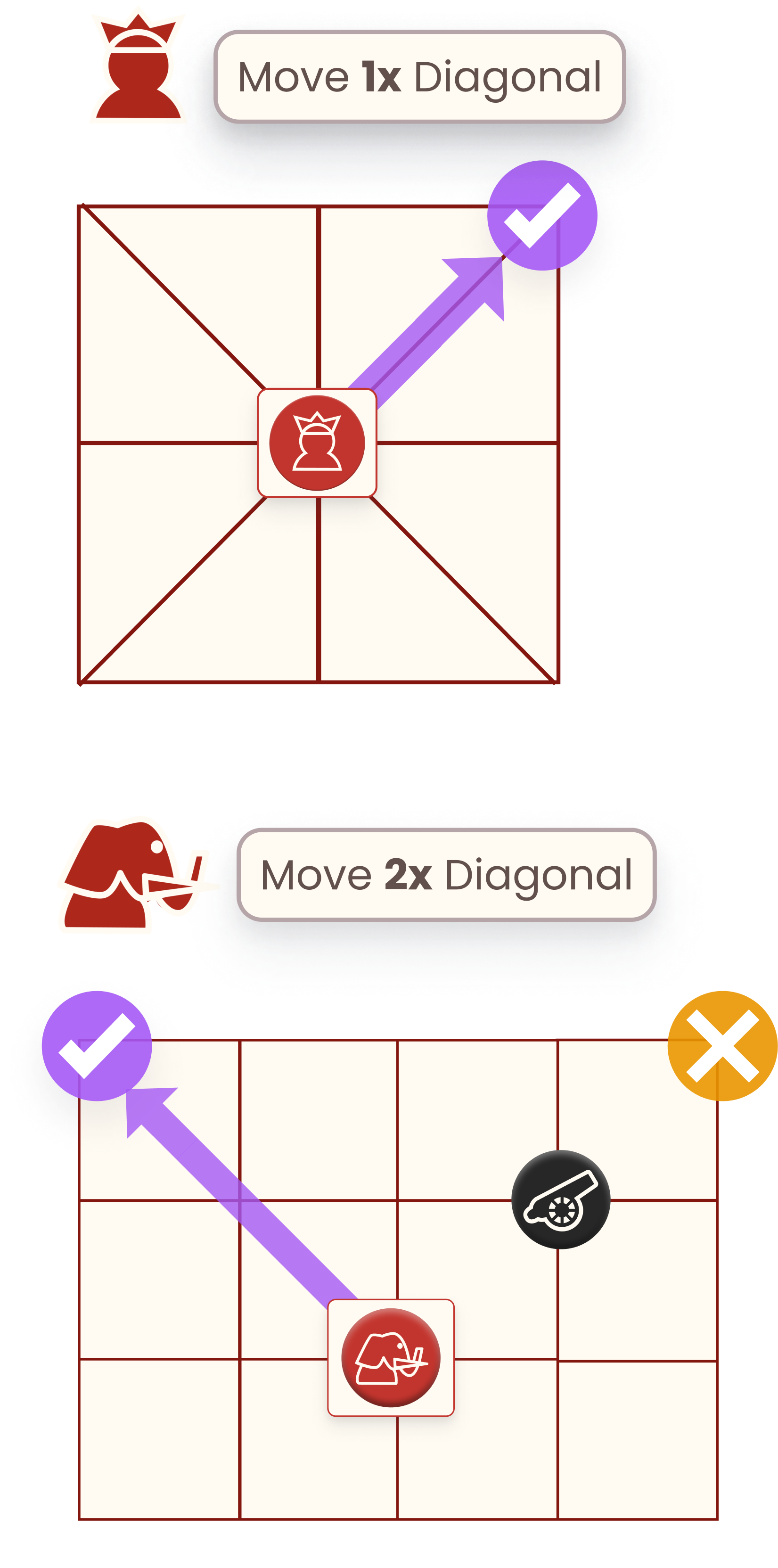Learning the Xiangqi Pieces and Moves
One of the first steps to playing Xiangqi starts with learning about each of the pieces and how they can move across the board.
For Beginners
Getting familiar with the Chinese chess pieces, including their names, moves, and special rules, is essential before you can dive into playing this ancient strategy game.
This guide will provide an overview of all the Xiangqi game pieces, their unique movements, and any special rules, like river-crossing with soldiers. With the basics of Chinese chess pieces and their moves, you'll be ready to start playing Xiangqi.
Watch this video to learn the fundamentals of how the pieces move in Xiangqi compared to Chess
What are the Chinese Chess Pieces Names?
Xiangqi, also known as Chinese chess, contains 7 unique pieces. The names of those Chinese Chess pieces are:
車/俥 Chariot
馬/傌 Horse
砲/炮 Cannon
卒/兵 Soldier
士/仕 Advisor
象/相 Elephant
將/帥 General
Why there are more than one Chinese name for a Xiangqi piece?
One unique characteristic of standard Xiangqi pieces is that the Chinese characters on each side's pieces are different. This is because, in ancient times, not everyone could afford colored ink to differentiate the red and black pieces. So the ancient Chinese made the characters different on each side for easy identification. The characters essentially mean the same thing though. If you are unfamiliar with the Chinese language, it is recommended to use the graphical pieces on xiangqi.com when starting to learn Xiangqi. The graphics on both sides' pieces are identical, avoiding any language barrier.
Are there any similarities between Xiangqi pieces and Chess pieces?
Some pieces in Chinese Chess have similarities to chess pieces in how they move or their strategic purposes. For example, the Xiangqi Chariot moves identically to the chess Rook, while the Xiangqi Horse has a similar L-shaped movement as the chess Knight. In the following sections, you will learn about the movements and relative values of each Xiangqi piece, and how they compare to their chess counterparts.
FAQ:
-
There are 7 pieces in Chinese chess: General, Chariot, Horse, Cannon, Soldier, Advisor, Elephant.
-
The pieces are called: General, Chariot, Horse, Cannon, Soldier, Advisor, Elephant.
-
The chinese characters on the pieces are: 帥/將, 車/俥, 馬/傌, 炮/砲, 兵/卒, 士/仕, 相/象. The characters are different for the same piece of red and black, but the meaning is the same
-
The chariot moves the same as the rook in chess. The horse moves in an L shape. The cannon moves like rook in chess but needs to jumps over a piece to capture. The soldier moves 1 space to the forward until it crosses the river, then it can move sideways. The advisor moves diagonally 1 space. The elephant moves diagonally 2 spaces.
-
The general is confined to the 3x3 palace and cannot face the enemy general. The advisors also cannot leave the palace. The elephant cannot cross the river. Soldiers gain mobility after crossing the river.
Offensive Pieces
The chariot moves exactly the same as a castle in Chess
Chariot
Movement of Chariot in Chinese Chess
The chariot (or rook) is the most powerful piece in Xiangqi. It moves in exactly the same way as the chess Rook. The chariot can move orthogonally as far as there are open positions, and he captures an opponent piece by landing on it.
Piece Value of Chariot in Chinese Chess
The chariot is worth 9 points.
FAQ:
-
The rook in xiangqi is called the chariot. It is the strongest piece in Xiangqi, worths 9 points
Horse
Movement of Horse in Chinese Chess
The horse moves similarly (but not exactly) to a knight in international chess. In xiangqi, the horse moves two positions in one direction, then continues to one in another direction. See the diagram.
If there is a piece in the horse’s path, it cannot jump over the piece. This is called “blocking his leg”.
Piece Value of Horse in Chinese Chess
The horse is worth 4 points in the opening and 4.5 points in the endgame, because it can be easily blocked in the opening but not in the endgame.
FAQ:
-
The horse is a Chinese Chess piece that moves in an L shape, one position in orthogonal direction, then one position diagonally
-
The horse moves in an L shape, one position in one orthogonal direction, then one position diagonally
-
Yes, the horse can cross the river.
Cannon
can move as many positions as are open horizontally or vertically. The cannon is unique to xiangqi, and it is a very powerful piece because of how it captures opponent pieces. The cannon must jump over a piece (the cannon mount) along its path (a piece from either army) and then land on its victim to capture.
The cannon worth 4.5 points in the opening and 4 point in the endgame, because there are lots of “mounts” in the opening but not in the endgame.
The Chinese word for cannon is pronounced “pow” which is incredibly fun. 🤩
FAQ:
-
The cannon is a unique piece in chinese chess that is being considered as a long-ranged weapon. It captures by jumping over another piece and landing on the enemy piece.
Soldier
Movement of Soldier in Chinese Chess
There are five soldiers (pawns). They can move forward one position at a time. The pawn captures by moving directly forward into a piece.
But, as you’ll see in the section on The River, when the soldier crosses the river in the center of the board, the pawn can then move and capture forward or sideways, one spot at a time.
Unlike international chess, the pawn does not get promoted to another piece when it reaches the last row.
Piece value of Soldier in Chinese Chess
The pawn is worth 1 point before the river, and 2 points after it has crossed the river.
FAQ:
-
Before crossing river, pawns capture by moving forward into the enemy piece. After crossing the river they can capture sideways too.
Defensive Pieces
Advisor
Movement of Advisor in Chinese Chess
The advisors can move diagonally one position at a time.
There are two advisors, one on each side of the general. As shown in the section on The Palace, the advisors cannot leave the palace area on the board.
Piece value of Advisor in Chinese Chess
The advisor is worth 2 points. It is crucial in defending against chariot.
Elephant
Movement of Elephant in Chinese Chess
The elephant moves diagonally by two positions. There cannot be a piece blocking its movement.
The elephant cannot cross The River.
Piece value of Elephant in Chinese Chess
The elephant is worth 2 points. The elephants are often used in conjunction to protect each other and the general. It is crucial in defending against the cannon.
FAQ:
-
The elephant moves diagonally two spaces.
-
The elephant moves diagonally two spaces.
-
No, the elephant cannot cross the river.
Elephant Chess
Elephant is pronounced “shiang” - written in English as “xiang”. This is where the game of xiangqi gets its name -- xiang means elephant, and “qi” means boardgame.
General
Movement of General in Chinese Chess
The general, like in chess, is the most important piece in xiangqi.
The goal of the game is to checkmate your opponent’s general.
The general moves one position at a time, horizontally or vertically, but is restricted to moving within The Palace walls.
Also, due to the flying general rule, two generals cannot “facing each other”, which means they cannot be placed on the same file without any pieces in between.
FAQ:
-
The general is the king piece in xiangqi. The ultimate target in the game is to capture the opponent’s general
-
The general can only move 1 space horizontally or vertically.
-
No, the general cannot move diagonally.
-
No, the generals cannot face each other directly.
-
According to the flying general rule, when both generals are on the same file without any pieces in between, the general can “fly” to capture the opponent’s general
The Palace
The Palace is a 3 x 3 box with a total of 9 positions inside. The General starts in the center at the bottom of the board. There’s an Advisor on either side of the General (A4 and A6 / J4 and J6). Any piece can enter the Palace, but neither the General or Advisors can leave.

